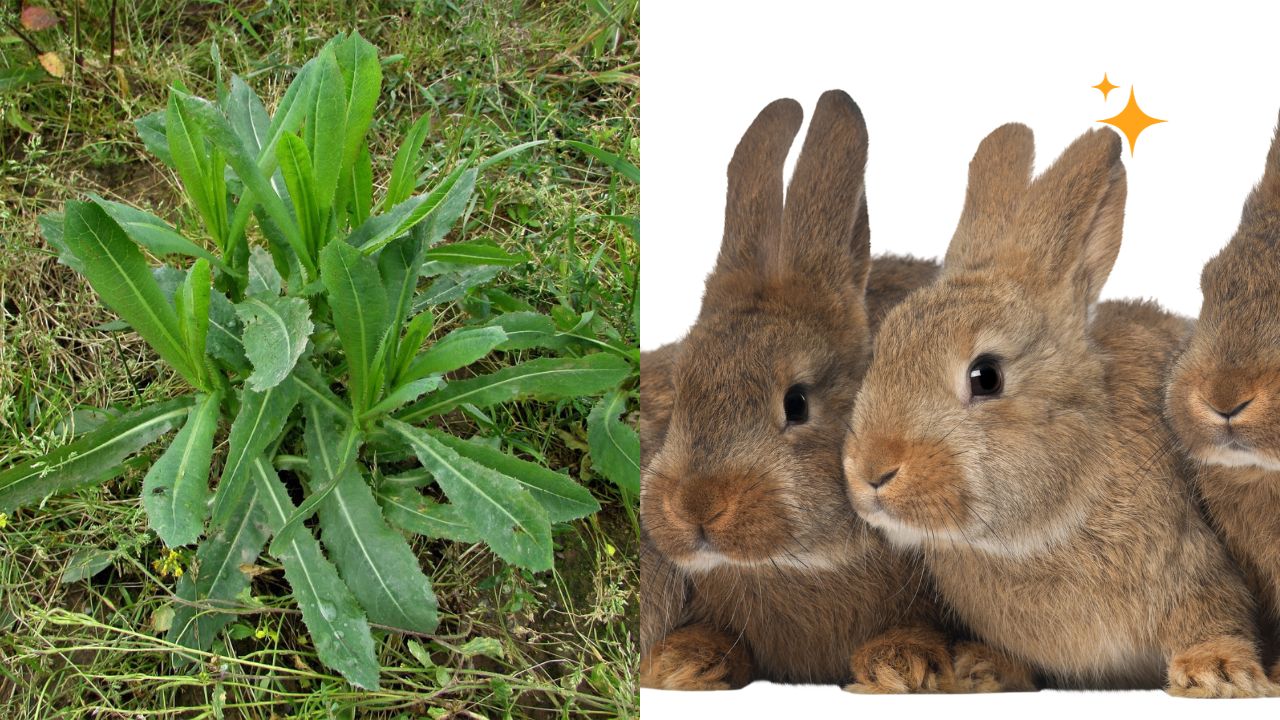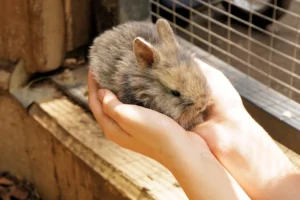Did you know that wild lettuce can be a nutritious addition to your rabbit’s diet?
Contrary to popular belief, rabbits can safely consume wild lettuce, benefiting from its high fiber content and essential vitamins.
However, it’s important to be aware of the potential risks and take precautions to ensure your furry friend’s well-being.
In this article, we’ll explore the nutritional benefits, risks, and recommended serving size of wild lettuce for rabbits, as well as provide expert tips on incorporating it into their diet.
In This Article
- 1 Key Takeaways
- 2 Nutritional Benefits of Wild Lettuce for Rabbits
- 3 Risks and Dangers of Feeding Wild Lettuce to Rabbits
- 4 How to Introduce Wild Lettuce Into Your Rabbit’s Diet
- 5 Recommended Serving Size of Wild Lettuce for Rabbits
- 6 Signs of Allergies or Digestive Issues in Rabbits Eating Wild Lettuce
- 7 Other Leafy Greens That Are Safe for Rabbits to Eat
- 8 Expert Tips for Incorporating Wild Lettuce Into Your Rabbit’s Diet
- 9 Frequently Asked Questions
- 9.1 Can Rabbits Eat Other Types of Lettuce Besides Wild Lettuce?
- 9.2 How Often Should Wild Lettuce Be Included in a Rabbit’s Diet?
- 9.3 Are There Any Specific Health Conditions or Age Restrictions That Would Make It Unsafe for Rabbits to Eat Wild Lettuce?
- 9.4 Can Wild Lettuce Be Given to Rabbits as a Treat or Should It Only Be Part of Their Regular Diet?
- 9.5 Are There Any Potential Side Effects or Risks Associated With Feeding Rabbits Wild Lettuce?
Key Takeaways
- Wild lettuce is rich in essential nutrients such as vitamins A and C, calcium, and potassium, making it a beneficial addition to a rabbit’s diet.
- However, wild lettuce contains toxic compounds like lactucarium and lactucin, which can lead to digestive issues, respiratory problems, and organ damage in rabbits.
- Rabbits may also experience allergic reactions to wild lettuce, resulting in itching, swelling, and difficulty breathing.
- It is important to introduce wild lettuce slowly and in small amounts, monitor the rabbit’s response for any signs of allergies or digestive issues, and consult with a veterinarian for specific recommendations to ensure a balanced diet.
Nutritional Benefits of Wild Lettuce for Rabbits
You should include wild lettuce in your rabbit’s diet because it provides numerous nutritional benefits.
Wild lettuce isn’t only beneficial for humans but also for rabbits. It’s rich in vitamins A and C, which play a crucial role in maintaining a healthy immune system and promoting good eyesight.
Additionally, wild lettuce contains minerals such as calcium and potassium, which are essential for maintaining strong bones and muscles in rabbits.
This leafy green also offers dietary fiber, aiding in proper digestion and preventing gastrointestinal issues in rabbits.
To incorporate wild lettuce into your rabbit’s diet, you can try adding it to their regular leafy greens mix or use it as a treat. However, it’s important to ensure that the wild lettuce is fresh, thoroughly washed, and free from any pesticides or chemicals.
Risks and Dangers of Feeding Wild Lettuce to Rabbits
Feeding wild lettuce to rabbits can pose risks and dangers to their health. It’s important to be aware of the potential health risks associated with this practice. Here are three reasons why you should avoid feeding wild lettuce to your rabbits:
- Toxicity: Wild lettuce contains compounds that can be toxic to rabbits, such as lactucarium and lactucin. Ingesting these substances can lead to digestive issues, respiratory problems, and even organ damage.
- Allergic reactions: Rabbits may have allergic reactions to wild lettuce, resulting in symptoms like itching, swelling, and difficulty breathing. These reactions can be severe and require immediate veterinary attention.
- Nutritional imbalance: While wild lettuce may seem like a natural food choice for rabbits, it lacks the necessary nutrients and fiber that domesticated rabbits require. Feeding wild lettuce as a primary food source can lead to malnutrition and other health problems.
To keep your rabbits safe and healthy, it’s best to stick to a balanced, commercially available rabbit diet and avoid introducing potentially harmful plants into their diet.
How to Introduce Wild Lettuce Into Your Rabbit’s Diet
Introducing wild lettuce into your rabbit’s diet can be done gradually and safely by mixing small amounts with their regular food. Wild lettuce, also known as Lactuca virosa, is a leafy green plant that is safe for rabbits to consume in moderation.
It is important to introduce new foods slowly to avoid digestive upsets or allergic reactions. Wild lettuce can provide potential health benefits for your rabbit, such as improved digestion and hydration. It is rich in vitamins A, C, and K, as well as minerals like calcium and magnesium.
However, it is important to note that while wild lettuce can be a nutritious addition to your rabbit’s diet, it should not replace their main diet of hay and fresh vegetables. Always consult with a veterinarian before introducing any new foods to your rabbit’s diet.
| Potential Health Benefits | Nutritional Content |
|---|---|
| Improved digestion | Vitamin A |
| Hydration | Vitamin C |
| Vitamin K | |
| Calcium | |
| Magnesium |
Recommended Serving Size of Wild Lettuce for Rabbits
If you’re considering incorporating wild lettuce into your rabbit’s diet, it’s recommended to start with small servings and gradually increase them. Wild lettuce can provide several potential health benefits for your furry friend. Here is a recommended serving size guide to help you introduce wild lettuce into your rabbit’s diet:
- Begin with a small serving size of about 1-2 leaves per day. This will allow your rabbit’s digestive system to adjust to the new food.
- After a few days, you can increase the serving size to 3-4 leaves per day. Monitor your rabbit’s response and adjust accordingly.
- Once your rabbit is accustomed to wild lettuce, you can gradually increase the serving size to 5-6 leaves per day, or as recommended by a veterinarian.
Remember to always consult with a veterinarian before making any changes to your rabbit’s diet. By following these recommended serving sizes, you can ensure your rabbit enjoys the potential health benefits of wild lettuce in a safe and controlled manner.
Signs of Allergies or Digestive Issues in Rabbits Eating Wild Lettuce
To ensure the well-being of your rabbit, monitor for any signs of allergies or digestive issues when they eat wild lettuce. Although wild lettuce is generally safe for rabbits to consume, it’s important to be aware of potential allergies and sensitivities that your rabbit may have.
Some rabbits may experience allergic reactions or digestive issues when eating wild lettuce, such as diarrhea or bloating. It’s recommended to introduce wild lettuce gradually into your rabbit’s diet and observe their response. If any signs of allergies or digestive issues occur, it’s best to consult with a veterinarian.
However, for rabbits without any allergies or sensitivities, wild lettuce can provide health benefits such as hydration, fiber, and essential nutrients. As with any food, it’s important to balance the intake to avoid any potential risks to your rabbit’s health.
Other Leafy Greens That Are Safe for Rabbits to Eat
You can feed your rabbit a variety of leafy greens that are safe for them to eat, such as kale, spinach, and parsley. These greens not only provide essential nutrients but also add variety to your rabbit’s diet. Here are three of the best leafy greens for rabbits:
- Kale: This nutrient-dense green is rich in vitamins A, C, and K. It also contains calcium, which is important for maintaining strong bones in rabbits.
- Spinach: Another nutritious option, spinach is packed with vitamins and minerals. It’s a good source of iron, which helps in the production of healthy red blood cells.
- Parsley: This herb isn’t only flavorful but also beneficial for your rabbit’s health. It’s a great source of vitamin C and can support their immune system.
Other common vegetables that are safe for rabbits to eat include romaine lettuce, cilantro, and dandelion greens. Remember to introduce new greens slowly and in small quantities to prevent digestive issues. Always consult with a veterinarian to ensure you’re providing the best diet for your furry friend.
Expert Tips for Incorporating Wild Lettuce Into Your Rabbit’s Diet
Including wild lettuce in your rabbit’s diet can provide them with additional nutrients and variety in their meals. Wild lettuce, also known as Lactuca serriola, is a safe and nutritious option for rabbits when incorporated into their diet in moderation. This leafy green is rich in vitamins A, C, and K, as well as minerals like calcium and potassium. These nutrients are essential for maintaining your rabbit’s overall health and well-being.
Additionally, wild lettuce contains fiber, which aids in digestion and helps prevent gastrointestinal issues. It’s important to note that while wild lettuce can be beneficial, it should be introduced gradually to avoid any digestive upsets. Always wash the leaves thoroughly and remove any traces of pesticides or chemicals before feeding them to your rabbit.
As with any new food, it’s advisable to consult with a veterinarian before incorporating wild lettuce into your rabbit’s diet to ensure their safety and well-being.
Frequently Asked Questions
Can Rabbits Eat Other Types of Lettuce Besides Wild Lettuce?
Yes, rabbits can eat other types of lettuce besides wild lettuce. Romaine lettuce is a safe and nutritious choice, while iceberg lettuce should be given sparingly due to its low nutritional value.
How Often Should Wild Lettuce Be Included in a Rabbit’s Diet?
To safely incorporate wild lettuce into your rabbit’s diet, consider feeding it occasionally as a treat or part of a varied diet. Wild lettuce can provide nutritional benefits, such as fiber and vitamins, but consult a veterinarian for specific guidelines.
Are There Any Specific Health Conditions or Age Restrictions That Would Make It Unsafe for Rabbits to Eat Wild Lettuce?
You need to be aware of health conditions and age restrictions when considering if it’s safe for rabbits to eat wild lettuce. It’s important to consult a veterinarian for specific guidance.
Can Wild Lettuce Be Given to Rabbits as a Treat or Should It Only Be Part of Their Regular Diet?
Yes, wild lettuce can be given to rabbits as a treat. It provides nutritional benefits, such as fiber and vitamins. However, it should only be part of their regular diet in moderation to ensure a balanced intake.
Are There Any Potential Side Effects or Risks Associated With Feeding Rabbits Wild Lettuce?
Feeding rabbits wild lettuce may have potential side effects and risks. However, it’s important to note that when given in moderation and as part of a balanced diet, rabbits can safely consume wild lettuce.





